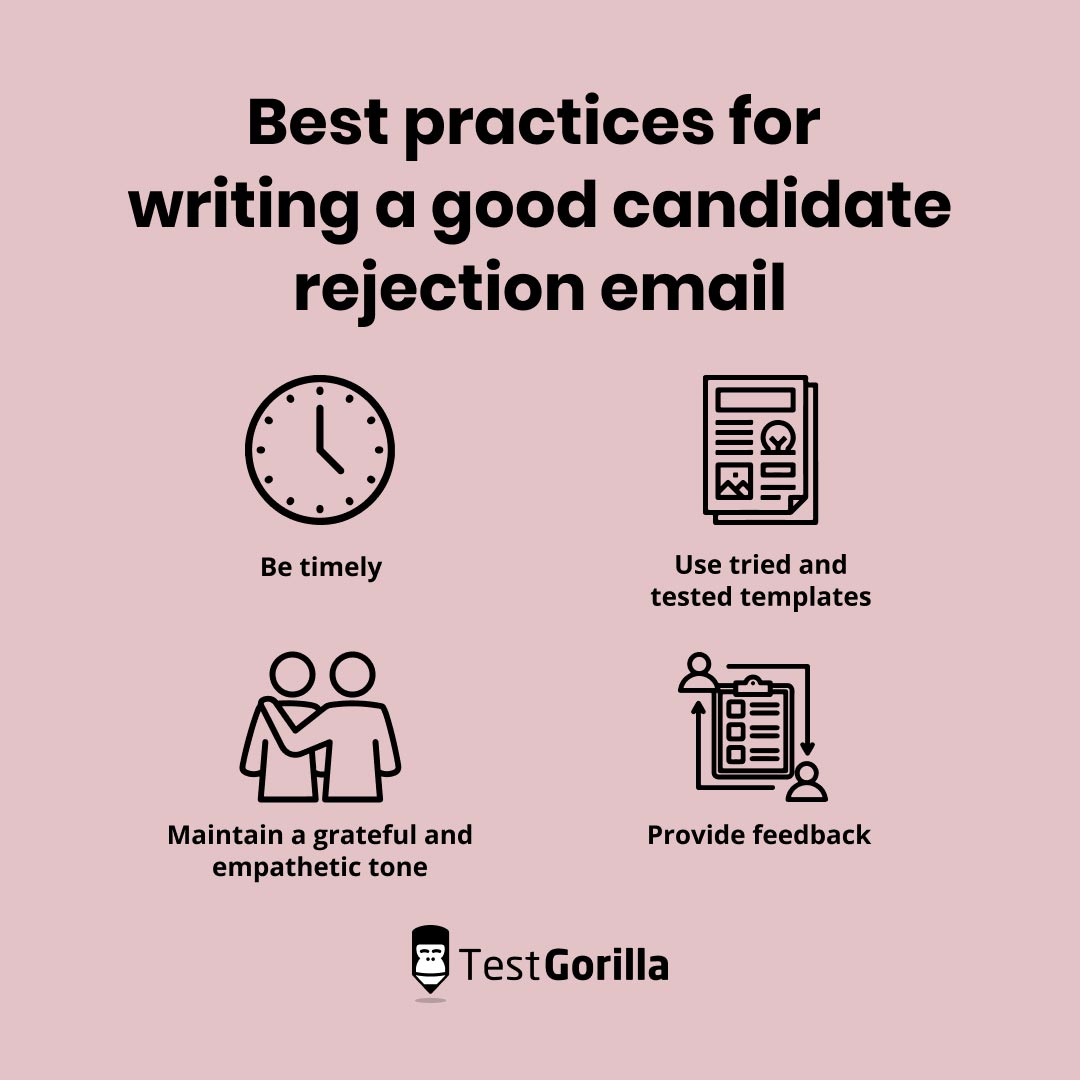With the rise of social media and websites like Glassdoor, candidates are quick to share their hiring experiences online. Negative reviews can damage your employer brand and make it difficult to attract top talent in the future.
That’s why you need to build a strong reputation even with the candidates you don’t end up hiring.
Writing the perfect candidate rejection email is a great way to do this. It’s the last time candidates will hear from you so it’s critical that you part ways respectfully and professionally – fostering a positive candidate experience.
In this guide, we explain why you need to write candidate rejection emails and share top tips on how to reject a candidate via email. What’s more, we also provide email templates so you can make quick and easy improvements to your hiring process starting today.
Table of contents
- What are candidate rejection emails?
- Why send candidate rejection emails
- How to write the perfect candidate rejection email
- Sample candidate rejection email templates
- Best practices for writing a good candidate rejection email
- How TestGorilla can simplify and improve your hiring process
- The bottom line on writing candidate rejection emails
What are candidate rejection emails?
A candidate rejection email is a courteous email communication sent by HR teams to job applicants, informing them that they haven’t been selected for a particular role. Candidate rejection emails are also referred to as job rejection emails.
The content in a job rejection email usually depends on what stage of the hiring process a candidate is rejected at. However, most candidate rejection emails have these common elements:
Gratitude for the candidate’s interest in the position and company
A brief explanation of the decision
Appreciation for the candidate’s time and effort
The aim of the email is to maintain a positive impression and cultivate goodwill with the candidate, encouraging them to apply for future opportunities in the company.
Why send candidate rejection emails
Sending job rejection emails should be an essential part of your hiring process. Here’s why:
It’s courteous and professional
It takes a considerable amount of time and effort for candidates to apply for a role, not to mention the investment incurred by those who’ve made it to the later stages of the process, such as undertaking tests or interviews.
Taking the time to write to them ensures you come off as courteous and professional in your hiring approach. The least you can do is let them know you aren’t progressing their applications. Some of these candidates are eager for the job and would rather be sent a rejection email than no communication at all.
It creates a positive candidate experience and avoids negative reviews
Candidates appreciate prompt and transparent communication from companies, even if it’s to reject their applications.
Taking the time out to keep them updated, and in some cases, providing feedback on their application can go a long way to building a positive candidate experience and strong employer reputation for your company.
It also helps prevent negative reviews and comments on social media and websites like Glassdoor.
It leaves the doors open
A well-crafted candidate rejection email leaves applicants with a good final impression and makes them feel respected by the company.
This is a great way to encourage them to apply for future roles or even engage with the company in a different capacity, for example, as a customer, investor, vendor, and so on.
It reaffirms the company’s culture and values
Taking the time to write to rejected candidates shows that you respect them and follow ethical business practices. It not only leaves a good impression on candidates but also reaffirms the company’s culture and values for existing employees.
It protects you from legal disputes
Job rejection emails that explain why candidates haven’t been selected help protect the company from potential legal disputes. For instance, if a candidate claims that you’ve rejected them unfairly, a job rejection email can show, in writing, why a candidate was rejected and that the reasons were clearly communicated to them.
How to write the perfect candidate rejection email
The length and level of detail in a candidate rejection email depends on how far along in the process that candidate was.
For instance, it’s okay to send a standard and automated rejection email if a candidate is being rejected at the resume screening stage. But, you probably need to provide a more personalized explanation for rejection at later stages. For example, if they were in their final rounds of interviews.
At the very minimum, your job rejection email should contain the following fundamental elements:
Neutral subject line
Choose a concise but neutral subject line such as “Thank you for your application” or “Update on your application.” It’s best for the candidate to receive the rejection with additional context in the main email body rather than through a negative or emotive subject line.
Personalized greeting or salutation
Ensure that you refer to the candidate by their name so it doesn’t appear like a standard automated response sent to everyone. Use a professional salutation such as “Dear” or “Hi” for formal or informal emails respectively.
Show gratitude and be specific about the role
Open the job rejection email on a positive note. You can do this by showing gratitude and thanking the candidate for applying for the role.
Importantly, be specific about what position and company the email pertains to. For example, “Thank you for your interest and application for the Administrative Assistant role at Company X.”
It’s common for candidates to apply for many roles across multiple companies simultaneously, so ensure they know exactly what role they’re being rejected from.
Clear job rejection messaging
Clearly state that they’re not being selected for the position. Use a neutral tone and keep the messaging straightforward. There should be no room for ambiguity or confusion about their application.
Feedback or reasons for rejection (optional)
It’s good practice to provide a reason for rejecting the candidate. For instance, the role has already been filled, or you’ve chosen someone whose qualifications are better suited.
Additionally, you can provide the candidate with personalized feedback about their performance during the application process. This is optional but highly recommended, especially for applicants who made it to the later stages of the hiring process.
Future opportunities and encouragement
Mention that you’ll keep the candidate’s resume on file and will reach out to them if any future roles open up that would suit their experience. Also, encourage them to keep an eye out for future job listings at your company.
Closing statement
End the email on a positive note, once again thanking the candidate for their application and interest in working at your company. You may offer to talk through the feedback in more detail over a call if they wish to, especially if the candidate progressed to the advanced stages of the application process. However, this is optional.
Contact information and signature
Make sure to include your name, designation, and contact details should the candidate need to reach out to you with any questions or feedback.
Sample candidate rejection email templates
Below, we’ve created three sample templates for your candidate rejection emails. Tailor these templates to personalize them for the candidate and the specific roles they relate to.
Sample 1: Job rejection email for candidates in the early stages of the application process
Subject: Thank you for your application
Dear [Candidate's Name],
Thank you for taking the time and effort to apply for the [Position Name] role at [Company Name].
After careful consideration, we regret to inform you that we will not be progressing with your application for this role.
While your skills and experience are commendable, we have decided to move forward with a candidate whose background aligns more closely with the specific requirements of the role.
We have your resume on file and will reach out to you if a suitable role opens up. In the meantime, we encourage you to check our careers page regularly for any future opportunities that may interest you.
We appreciate your understanding and value your interest in joining our team.
Kind regards,
[Your Name]
[Your Title]
[Company Name]
[Your Email Address]
[Your Phone Number]
Sample 2: Job rejection email for candidates in the later stages of the application process
Subject: Feedback on your job application
Dear [Candidate's Name],
Thank you for your interest in the [Position Name] role at [Company Name]. We appreciate your time and effort throughout the application process.
Unfortunately, after careful consideration, we have decided not to progress your application for the [Position Name] role.
While your skills and experience are impressive, we were seeking more direct experience in [specific skill or experience required for the role] which was a key factor in our decision.
We genuinely appreciate your interest and encourage you to check our careers page regularly for any future opportunities that may interest you.
Please feel free to contact me if you have any questions.
Kind regards,
[Your Name]
[Your Title]
[Company Name]
[Your Email Address]
[Your Phone Number]
Sample 3: Job rejection email for company-related reasons
Subject: Update on your job application
Dear [Candidate's Name],
Thank you for your interest in the [Position Name] role at [Company Name].
We regret to inform you that we are no longer hiring for this role. The decision was influenced by [specific reasons e.g. team restructuring], which has led us to re-evaluate the scope and requirements of the [Position Name] role.
We genuinely appreciate the time and effort you invested in the application process and encourage you to check our careers page regularly for any future opportunities that may interest you.
Thank you for your understanding.
Best regards,
[Your Name]
[Your Title]
[Company Name]
[Your Email Address]
[Your Phone Number]
Best practices for writing a good candidate rejection email
Follow these best practices to write effective job rejection emails and create a positive candidate experience for all applicants.
Best practice | Description |
Be timely | Write and send job rejection emails as soon as you’ve made the decision. If you’ve promised to get back to a candidate by a certain time, be sure to stick to it. |
Use tried and tested templates | Create templates for different job rejection scenarios. Use the most effective ones for your job rejection emails. Be sure to personalize them so they don’t appear automated or scripted. |
Maintain a grateful and empathetic tone | Ensure that your job rejection email is kind and empathetic. Rejection is already bad news for a candidate so keep the tone as grateful and encouraging as possible. |
Provide feedback | Where possible, tell candidates why they weren’t hired or what they can do to succeed in future applications. |
How TestGorilla can simplify and improve your hiring process
Hiring teams are often swamped with screening resumes, scheduling interviews, setting up tests, and so on. Unfortunately, this means they often forget to write and send candidate rejection emails or follow the above best practices.
That’s why it’s a great idea to use software like TestGorilla to take the pain out of candidate rejections. You can use TestGorilla’s dashboard to send rejection emails to your candidates in just a few clicks.
Moreover, you can create custom templates that reflect your voice and employer brand and save you the hassle of writing them from scratch every time.
TestGorilla lets you send candidates their results for pre-employment tests and assessments, including situational judgment, cognitive ability, and job-specific skills tests, to name a few.
Sharing these results adds another layer of feedback and can help put the rejection decision into context. For instance, you could explain in your email that a candidate was rejected because they didn’t pass the minimum required grade on the problem-solving test.
The bottom line on writing candidate rejection emails
Sending a well-thought-out candidate rejection email to your applicants makes them feel respected and valued despite not getting the role. This is a great way to encourage future applications from them and avoid negative reviews online.
However, rejecting applicants is sensitive and it can be tricky to know how to reject a candidate via email. The perfect candidate rejection email will be personalized and concise, and provide candidates with specific feedback about their application.
Maintaining a positive and empathetic tone throughout your email and sending it on time also goes a long way in building a positive candidate experience and a strong employer brand for your company.
Use software like TestGorilla to create custom templates, manage communications, and send candidates specific feedback about their performance in the application process.
Take a product tour, schedule a free 30-minute live demo, or sign up for a free plan to start crafting and sending effective candidate rejection emails today.
Related posts
Hire the best candidates with TestGorilla
Create pre-employment assessments in minutes to screen candidates, save time, and hire the best talent.
Latest posts
The best advice in pre-employment testing, in your inbox.
No spam. Unsubscribe at any time.

Hire the best. No bias. No stress.
Our screening tests identify the best candidates and make your hiring decisions faster, easier, and bias-free.
Free resources
This checklist covers key features you should look for when choosing a skills testing platform
This resource will help you develop an onboarding checklist for new hires.
How to assess your candidates' attention to detail.
Learn how to get human resources certified through HRCI or SHRM.
Learn how you can improve the level of talent at your company.
Learn how CapitalT reduced hiring bias with online skills assessments.
Learn how to make the resume process more efficient and more effective.
Improve your hiring strategy with these 7 critical recruitment metrics.
Learn how Sukhi decreased time spent reviewing resumes by 83%!
Hire more efficiently with these hacks that 99% of recruiters aren't using.
Make a business case for diversity and inclusion initiatives with this data.


















